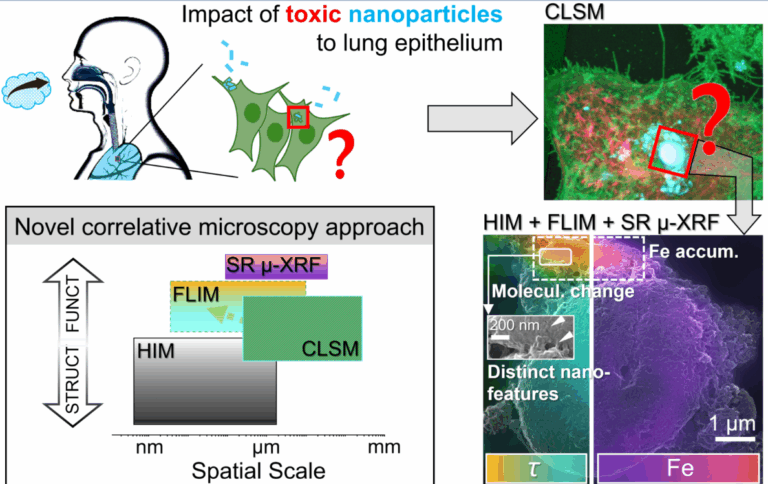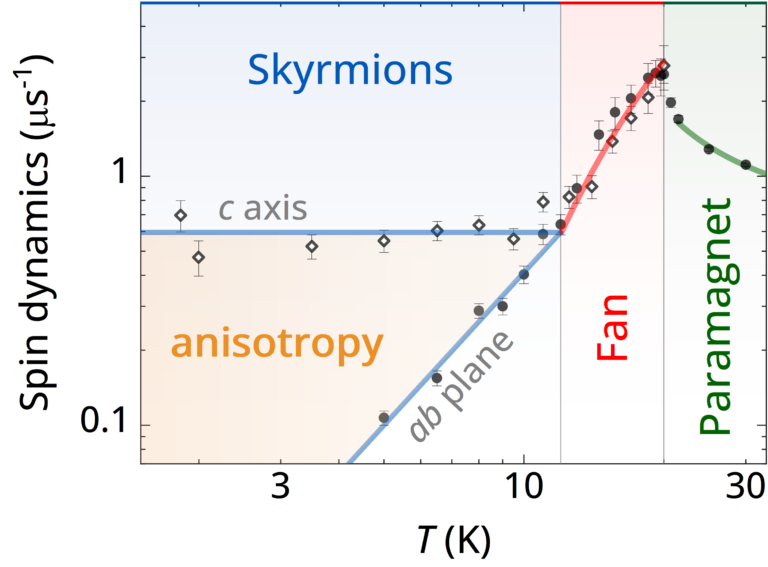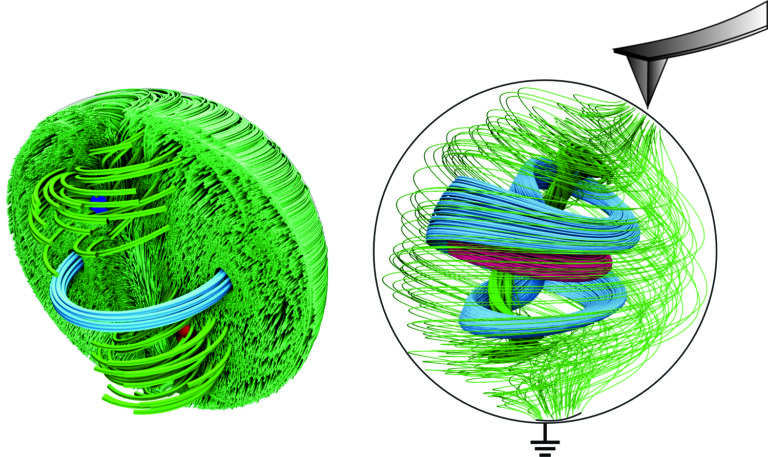News

Article in the journal ACS Nano
Rok Podlipec, Luka Pirker, Ana Krišelj, and Primož Pelicon from the Condensed Matter Physics Departments and the Department of Low and Medium Energy Physics, in collaboration with colleagues from the Helmholtz-Zentrum Dresden-Rossendorf (Germany) and Elettra-Sincrotrone (Italy), have published an article in the journal ACS Nano presenting new approaches in advanced high-resolution correlative microscopy to uncover mechanisms of interaction between harmful nanoparticles and lung epithelium.
In their study, they used complementary optical, electron, and ion microscopy techniques on the same samples to analyze the relationship between the structural and functional characteristics of cellular responses to TiO₂ nanoparticles and their biological effects.
Key findings include extensive accumulation of essential minerals and iron, binding of DNA molecules, and localized formation of fibrous structures on the surface of lung cells where nanoparticles were immobilized. These processes confirm the activation of immune responses and contribute to a better understanding of the early stages of inflammation. The developed experimental approach provides a solid foundation for future research into the initial mechanisms of nanoparticle toxicity in biological systems at the nanoscale.

Uroš Tkalec named APS Outstanding Referee
Associate Prof. Dr. Uroš Tkalec is one of this year’s honorees of the Oustanding Referee Program. The lifetime award is granted by the American Physical Society (APS), which has more than 50.000 members from all over the world. Each year, the editors of the APS select around 150 of the best referees for papers to be published in their journals, with the number and quality of reviews being the main criteria. So far, ten physicists at Slovenian research institutions have received this award, including F-5 members Prof. Dr. Slobodan Žumer and Prof. Dr. Robert Blinc.
More information can be found here:
https://journals.aps.org/OutstandingReferees

Anisotropic Skyrmion and Multi-q Spin Dynamics in Centrosymmetric Gd2PdSi3
Matjaž Gomilšek from the Condensed Matter Physics Department at the Jožef Stefan Institute and the Faculty of Mathematics and Physics, University of Ljubljana has published a paper Anisotropic Skyrmion and Multi-q Spin Dynamics in Centrosymmetric Gd2PdSi3 in Physical Review Letters as the leading author, together with co-authors from the UK, Switzerland, Germany, Canada, and Japan. In the paper they discover a pronounced directional dependence of magnetic dynamics in topologically-protected whirls of magnetization called skyrmions. The observed behavior is very unusual, since the studied material is highly symmetrical. The researchers also discover a strong directional dependence of magnetic dynamics in the previously-unidentified ground state of the material, which suggests that it is the much-sought-after lattice of merons (“halves” of a skyrmion). These discoveries significantly contribute to solving the puzzle of the stability of topological magnetic textures in highly symmetrical materials.
Skyrmions can be used for data storage, spintronics (a magnetic analogue of electronics), or as a platform for advanced (reservoir-computing) artificial intelligence.

Topological foundations of ferroelectricity
An international team of scientists published a new review article titled “Topological foundations of ferroelectricity” in the journal Physics Reports (Impact Factor: 23.9). The article explores the fundamental role of topology in ferroelectric materials. Researcher Dr. Anna Razumnaya from Jozef Stefan Institute, in collaboration with researchers from the University of Picardie, IFW Dresden, the University of Toronto, and Terra Quantum AG, provided a groundbreaking framework for understanding and classifying complex polarization structures in nanostructured ferroelectrics, paving the way for future technological applications. Ferroelectric materials have long been studied for their unique electrical properties and applications in memory devices, sensors, and energy-efficient electronics. Recent discoveries have revealed that these materials can host a variety of exotic topological states, including vortices, skyrmions, and Hopfions. By drawing parallels between hydrodynamics and electrostatics, the study introduces a comprehensive classification of these topological states and their impact on the behavior of ferroelectrics.
This research demonstrates how fundamental topological concepts, such as helicity, fibration, and ergodicity, can be applied to ferroelectric materials to better understand and manipulate their polarization structures. This work expands the theoretical foundations of ferroelectricity and opens new avenues for the design of next-generation functional materials. By bridging topology with condensed matter physics, this study opens new prospects for the development of polar materials, including traditional ferroelectrics and newly discovered soft ferroelectric materials, while also advancing the frontiers of their potential applications in cutting-edge electronic devices.… Read the rest “Topological foundations of ferroelectricity”

Incommensurable matter-wave jets in quasi-1D geometry
Bose-Einstein condensates subjected to modulation of the interaction between atoms exhibit the emergence of density waves and matter-wave jets with a velocity proportional to the square root of the modulation frequency. In the newly published paper, the authors present the experimental observation of higher-order incommensurable “golden” matter-wave jets emerging from a Bose-Einstein condensate exposed to a single frequency interaction modulation. The formation of higher-order jets in quasi-one-dimensional geometry is modelled using numerical one-dimensional (1D) Gross-Pitaevskii equation simulation. The authors explore the process of jet formation experimentally and theoretically for a wide range of modulation amplitudes and frequencies and establish a phase diagram delineating different regimes of jet formation.
